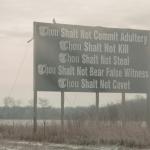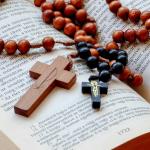Before Roe, before the culture wars, before the 60s, Will Herberg was observing social dynamics that, he argued, would initially put Protestants and Catholics more sharply at odds but eventually push them together. The key shift was the move of Catholics into the mainstream of American middle-class life. At the time he wrote, there had been no dramatic spike in Catholic immigration, yet Protestants felt that Catholics were suddenly invading. They were, and Protestants experienced the invasion as a loss of a country that had once been ours:
The mass of the older Protestants have had their attitudes formed in an America that understood itself as a Protestant nation; the country, in a very real sense, was theirs, belonged to them, was their home. Now, within one generation, their own generation, the country has, almost literally, been taken away from them, to be parcelled out among the ‘three major faiths’: what was once their own home they are now being compelled to share with two interloper groups. No wonder they feel dispossessed; no wonder they feel threatened. There was a time, not so long ago, when the middle-class Protestant in this country hardly came across a Catholic in those community institutions and organizations that really counted. There were, of course, many Catholics around, but they were largely at the margin of society, laborers and servant girls, hewers of wood and drawers of water. But within the past generation American Catholics have advanced dramatically from a peripheral, foreign, lower-class group to a nuclear, middle-class American community. Today, the Protestant, wherever he turns in community life, confronts Catholics on every side; no wonder he is convinced that Catholics have multiplied enormously and are taking over the coimtry, whatever the statistics may say. Once, too, the general American institutions were simply Protestant institutions. Protestants did not need any separate organizations of their own, because the general community organizations and institutions were Protestant and obviously theirs. Jews and Catholics, on the other hand, and incidentally Negroes too had begun their very existence in American life as minority groups, requiring special institutions, organizations, and agencies to represent and protect them, and these institutions, organizations, and agencies they rapidly built up. Today, Protestants, in most parts of the country, can no longer take the general community institutions for granted as theirs; but (aside from the Negro group) they have not managed to develop any significant institutions of their own, or at least did not get to developing these till very late. As a consequence, they frequently find themselves at a great disadvantage and are very resentful at the ‘separatism’ of the Catholics and Jews, whose institutions they denounce as ‘divisive’ and ‘un-American.’ All in all, the older Protestants in most parts of the country find themselves in a very frustrating position; it is no wonder that they have tended to develop an outlook that the editor of the Christian Century has very aptly, and with not too much exaggeration, described as ‘Protestant paranoia’ (40).
Of course, fifty years on, Protestants have created our own subculture and are ourselves denounced as divisive and sectarian, a threat to the children we indoctrinate in our schools.
Meanwhile, Catholics felt that they were denied proper recognition as Americans, and felt “hampered and closed in.” Alongside Protestant paranoia, the Century diagnosed a “Catholic claustrophobia” (41). The combination makes for resty relations, and Herberg saw “a certain exacerbation of Protestant-Catholic tensions:” (41).
It wouldn’t last forever. For one thing, younger Protestants grew up in a social world full of Catholics, and so were less threatened than their parents. Herberg summarizes the attitude of younger Protestants with: “What’s all the excitement about? So they are Catholics! But they’re our kind of people, and after all, we’re all Americans, aren’t we?” (42). Catholics had accepted the common faith in/of America, and so were accepted into the koinonia of American life.
As Herberg sees it, this is a sign of the increasing “secularization” of American life—that is, the increasing gap between “conventional” and “operational” religion: “the promising alleviation of religious group tensions would appear to be due to the advancing secularization of American life and religion” (42).
Herberg astutely recognizes the existence of another form of Protestant-Catholic convergence that is not based on common share in the American way of life. Rather, “it comes from the opposite direction”: “Of recent years, we know, there has been a rapprochement, in America as in Europe, between theologically concerned Protestants and Catholics, even between theologically concerned Christians and Jews, precisely as a consequence of their theological concern. It is not the “common religion” of the American Way that binds them; it is rather their common Christian, their common Biblical, faith and understanding. Indeed, suspicion of the American Way as a substitute-religion serving Americans as their ultimate context of meaning and value is a common premise. Whereas, for the great mass of Americans, the operative formula is ‘After all, we’re all Americans,’ for the theological elite, it would run something like, ‘After all, we’re all Christians, standing on the same Bible,’ or, where Jews are included, ‘After all, we acknowledge the same God and recognize in Abraham our common father in the faith’” (43).
The Americanist/secular convergence and the catholic convergence aren’t the same thing, though they are “often confused under the vague rubrics of ‘tolerance,’ ‘unity,’ and ‘ecumenicity’” (43). The latter, not the former, is the basis for a genuine catholicity, one that resists rather than accommodates to secularization.
(Herberg, “Religion in a Secularized Society: The New Shape of Religion in America: Some Aspects of America’s Three Religion Pluralism,” Review of Religious Research 3 (1962) 33-45.)















